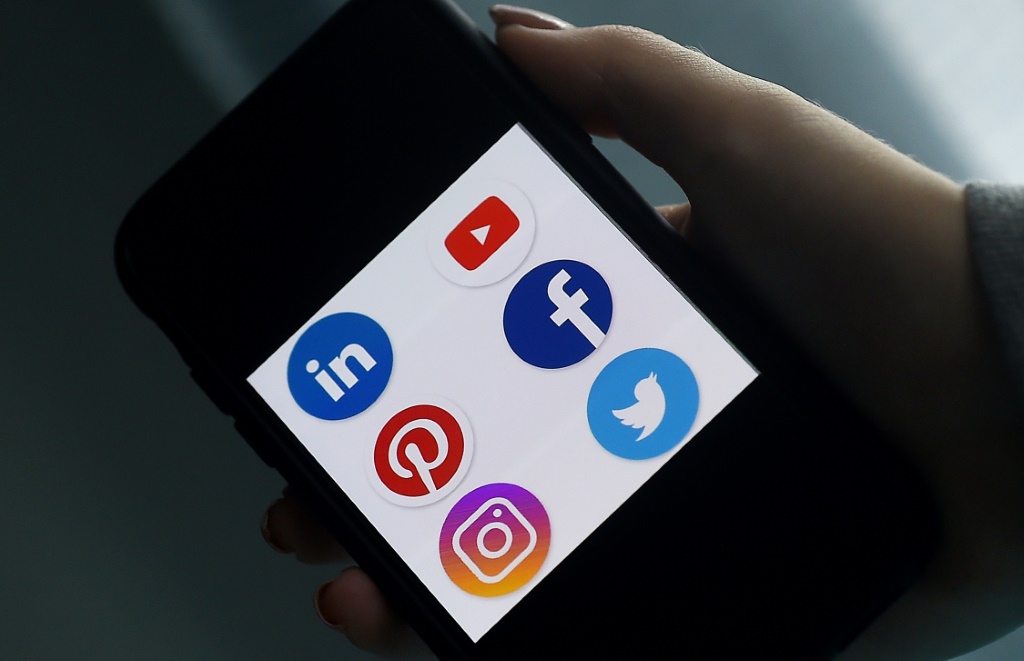SOCIAL
Social media: Past failures provided the steps for today’s giants to climb

Social media operators face a conundrum dealing with content labeled satire, which may also be harmful misinformation. — © AFP
When you consider successful social media there is a tendency to veer towards platforms like TikTok that have seen astronomical success in their short availability, or perhaps YouTube and the ability it has given creators to generate a steady income from uploading content.
However, not all social media is successful. Some platforms were successful for a period; others straightforward ‘failures’, although each arguably paved the way to establish what the collective entity of social media.
Recently the firm Higher Visibility analyzed social media sites over the past thirty years in a bid to discover those that ‘failed’ by losing popularity or ceased to exist altogether. Following this, Higher Visibility monitored where these sites sat when compared to modern social media platforms that continue to be widely used. By social media, this refers to platforms that enable users to create and share content or to participate in social networking.
After assessing the social media sites over the past thirty years, High Visibility gathered information from Statista and site information pages to discover the year they were created, the year they closed down or lost popularity (if applicable), and their highest monthly active users.
Whether any social media platform truly failed is contentious, since many of these platforms offered learning opportunities and paved the way for the platforms in common use today.
Taking some examples, Vine, a platform launched in 2013 saw rapid growth due to 6-second looping videos that could be experimented with to achieve creative results. Yet what was once the attraction point of the platform quickly became its downfall, with former executives citing the introduction of Instagram’s 15-second video clips in 2013 as one of the big issues. Vine came in as the 15th most successful social media on the Higher Visibility list, despite its ‘failing’.
One of the apps born from this new preoccupation with video content was Musical.ly. The platform allowed users to create videos lip-syncing to popular music, and there was a great emphasis on the promotional aspect of these through the app. Musical.ly was ultimately wildly successful despite ‘failing’ due to closing down, as it went on to be acquired by ByteDance and eventually merged into TikTok.
Friendster is often touted as an ‘early version’ of Facebook, boasting 51,010,000 monthly active users at its highpoint, paving the way for the platform that would come. The platform took off in 2003, reaching up to 4,470,000 members, and received a 30 million dollar offer from Google to buy the site. The founder, Jonathan Abrams decided instead to pursue venture capital investment. Users fell out of favour with the platform as it was not able to manage the pace of new subscribers.
MySpace followed Friendster as the brainchild of Tom Anderson, Chris DeWolfe and their friends. They modelled the site on Friendster, removing redundant features and centring the site around personal communities. MySpace was purchased in 2005 for 580 million dollars, however, later suffered due to the rising popularity of Facebook.
Of all the ‘successful’ social media platforms of the past 30 years within the full study, Facebook continues to have the highest monthly active users.
SOCIAL
Snapchat Explores New Messaging Retention Feature: A Game-Changer or Risky Move?

In a recent announcement, Snapchat revealed a groundbreaking update that challenges its traditional design ethos. The platform is experimenting with an option that allows users to defy the 24-hour auto-delete rule, a feature synonymous with Snapchat’s ephemeral messaging model.
The proposed change aims to introduce a “Never delete” option in messaging retention settings, aligning Snapchat more closely with conventional messaging apps. While this move may blur Snapchat’s distinctive selling point, Snap appears convinced of its necessity.
According to Snap, the decision stems from user feedback and a commitment to innovation based on user needs. The company aims to provide greater flexibility and control over conversations, catering to the preferences of its community.
Currently undergoing trials in select markets, the new feature empowers users to adjust retention settings on a conversation-by-conversation basis. Flexibility remains paramount, with participants able to modify settings within chats and receive in-chat notifications to ensure transparency.
Snapchat underscores that the default auto-delete feature will persist, reinforcing its design philosophy centered on ephemerality. However, with the app gaining traction as a primary messaging platform, the option offers users a means to preserve longer chat histories.
The update marks a pivotal moment for Snapchat, renowned for its disappearing message premise, especially popular among younger demographics. Retaining this focus has been pivotal to Snapchat’s identity, but the shift suggests a broader strategy aimed at diversifying its user base.
This strategy may appeal particularly to older demographics, potentially extending Snapchat’s relevance as users age. By emulating features of conventional messaging platforms, Snapchat seeks to enhance its appeal and broaden its reach.
Yet, the introduction of message retention poses questions about Snapchat’s uniqueness. While addressing user demands, the risk of diluting Snapchat’s distinctiveness looms large.
As Snapchat ventures into uncharted territory, the outcome of this experiment remains uncertain. Will message retention propel Snapchat to new heights, or will it compromise the platform’s uniqueness?
Only time will tell.
SOCIAL
Catering to specific audience boosts your business, says accountant turned coach

While it is tempting to try to appeal to a broad audience, the founder of alcohol-free coaching service Just the Tonic, Sandra Parker, believes the best thing you can do for your business is focus on your niche. Here’s how she did just that.
When running a business, reaching out to as many clients as possible can be tempting. But it also risks making your marketing “too generic,” warns Sandra Parker, the founder of Just The Tonic Coaching.
“From the very start of my business, I knew exactly who I could help and who I couldn’t,” Parker told My Biggest Lessons.
Parker struggled with alcohol dependence as a young professional. Today, her business targets high-achieving individuals who face challenges similar to those she had early in her career.
“I understand their frustrations, I understand their fears, and I understand their coping mechanisms and the stories they’re telling themselves,” Parker said. “Because of that, I’m able to market very effectively, to speak in a language that they understand, and am able to reach them.”Â
“I believe that it’s really important that you know exactly who your customer or your client is, and you target them, and you resist the temptation to make your marketing too generic to try and reach everyone,” she explained.
“If you speak specifically to your target clients, you will reach them, and I believe that’s the way that you’re going to be more successful.
Watch the video for more of Sandra Parker’s biggest lessons.
SOCIAL
Instagram Tests Live-Stream Games to Enhance Engagement

Instagram’s testing out some new options to help spice up your live-streams in the app, with some live broadcasters now able to select a game that they can play with viewers in-stream.
As you can see in these example screens, posted by Ahmed Ghanem, some creators now have the option to play either “This or That”, a question and answer prompt that you can share with your viewers, or “Trivia”, to generate more engagement within your IG live-streams.
That could be a simple way to spark more conversation and interaction, which could then lead into further engagement opportunities from your live audience.
Meta’s been exploring more ways to make live-streaming a bigger consideration for IG creators, with a view to live-streams potentially catching on with more users.
That includes the gradual expansion of its “Stars” live-stream donation program, giving more creators in more regions a means to accept donations from live-stream viewers, while back in December, Instagram also added some new options to make it easier to go live using third-party tools via desktop PCs.
Live streaming has been a major shift in China, where shopping live-streams, in particular, have led to massive opportunities for streaming platforms. They haven’t caught on in the same way in Western regions, but as TikTok and YouTube look to push live-stream adoption, there is still a chance that they will become a much bigger element in future.
Which is why IG is also trying to stay in touch, and add more ways for its creators to engage via streams. Live-stream games is another element within this, which could make this a better community-building, and potentially sales-driving option.
We’ve asked Instagram for more information on this test, and we’ll update this post if/when we hear back.
-

 SEO6 days ago
SEO6 days agoGoogle Limits News Links In California Over Proposed ‘Link Tax’ Law
-

 SEARCHENGINES6 days ago
SEARCHENGINES6 days agoGoogle Core Update Volatility, Helpful Content Update Gone, Dangerous Google Search Results & Google Ads Confusion
-
SEARCHENGINES7 days ago
Daily Search Forum Recap: April 12, 2024
-

 SEO6 days ago
SEO6 days ago10 Paid Search & PPC Planning Best Practices
-

 MARKETING6 days ago
MARKETING6 days ago2 Ways to Take Back the Power in Your Business: Part 2
-

 SEARCHENGINES5 days ago
SEARCHENGINES5 days agoWeekend Google Core Ranking Volatility
-

 MARKETING4 days ago
MARKETING4 days ago5 Psychological Tactics to Write Better Emails
-

 PPC6 days ago
PPC6 days agoCritical Display Error in Brand Safety Metrics On Twitter/X Corrected















You must be logged in to post a comment Login